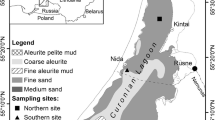Abstract
Short experiments (14–21 days) were carried out during autumn 1998 and spring 1999 at one selected site of the Venice Lagoon to measure bioturbation activities and mixing rates, as well as to obtain quantitative information on benthos functionality. Fluorescent sediment particles (luminophores, 63–350 μm) were introduced as pulse inputs at the sediment surface. The concentration–depth profiles of the tracer were simulated with a new advection–diffusion–non local model applied under non-steady state conditions. This allowed the quantification of the mixing parameters associated with different mechanisms: biodiffusion (D b), bioadvection (W) and non-local mixing (Ke, z1, z2). A parameter RS (removed sediment) was also calculated to account for the flux of sediment due to non-local transport. Results show that bioturbation was dominated by biodiffusion in autumn and by bioadvection in spring. Mean mixing parameters Db, W, and RS changed from 3.09 to 0.87 cm2 y−1, from 0.93 to 15.50 y−1 and from 5.85 to 7.79 g cm−2 y−1, respectively.
Similar content being viewed by others
References
Aller, R. C. & J. K. Cochran, 1976. 234Th/238U Disequilibrium in near-shore sediment: particle reworking and diagenetic time scales. Earth Planet. Sci. Lett. 29: 37-50.
Aller, R. C., 1982. The effects of macrobenthos on chemical properties of marine sediment and overlying water. In: McCall & M. J. S. Tevesz (eds), Animal-Sediment Relations, Plenum Press, New York: 53-102.
Benninger, L. K., R. C. Aller, J. K. Cochran & K. K. Turekian, 1979. Effects of biological sediment mixing on the 210Pb chronology and trace metal distribution in a Long Island Sound sediment core. Earth Planet. Sc. Lett. 43: 241-259.
Berner, R. A., 1980. Early Diagenesis. A Theoretical Approach. Princeton University press, Princeton (N.J), 241 pp.
Boudreau, B. P., 1986. Mathematics of tracer mixing in sediments: II Non local mixing and biological conveyor-belt phenomena. Am. J. Sci. 286: 199-238.
Boudreau, B. P., 1997. Diagenetic models and their implementation. Springer-Verlag, Berlin/Heidelberg: 414 pp.
Cochran, J. K., 1985, Particle mixing rates in sediments of the eastern equatorial Pacific: evidence from 210Pb, 239,240Pu and 137Cs distributions at MANOP sites. Geochim. Cosmochim. Acta 49: 1195-1210.
Clifton, R. J.,1991. The use of radionuclides in describing the mixing characteristics of estuarine sediments. In: Kershaw P. J. & D. S. Woodhead (eds), Radionuclides in the Study of Marine Processes), Elsevier Applied Sciences. London 393 pp.
Fisher, J. B., W. J. Lick, P. L. McCall, & J. A. Robbins, 1980. Vertical mixing of lake sediments by tubificid oligochaetes. J. Geophys. Res. 85, C7: 3997-4006.
François, F., J. C. Poggiale, J. P. Durbec & G. Stora, 1997. A new approach for the modelling of sediment reworking induced by a macrobenthic community. Acta Biotheor. 45: 295-319.
Gardner, L. R., P. Sharma & W. S. Moore, 1987, A regeneration model for the effect of bioturbation by fiddler crabs on 210Pb profiles in salt marsh sediments. J. Environ. Rad. 5: 25-36.
Gerino, M., 1990. The effect of bioturbation on particle redistribution in Mediterranean coastal sediment. Preliminary results. Hydrobiologia 207: 251-258.
Gerino, M., G. Stora & J. P. Durbec, 1994. Quantitative estimation of biodiffusive and bioadvective sediment mixing: in situ experimental approach. Oceanol. Acta 17: 547-554.
Gerino, M., R. C. Aller, C. Lee, J. K. Cochran, J. Y. Aller, M. A. Green & D. Hirschberg, 1998. Comparison of different tracers and methods used to quantify bioturbation during a bloom: 234Thorium, luminophores and chlorophyll a. Estuar. Coast. Shelf Sci. 46: 531-547.
Guinasso, N. L. & D. R. Schink, 1975. Quantitative estimates of biological mixing rates in abyssal sediments. J. Geophys. Res. 80 (21): 3032-3043.
Officer, C. B. & D. R. Lynch, 1982. Interpretation procedures for the determination of sediment parameters from time-dependent flux inputs. Earth Planet. Sci. Lett. 61: 55-62.
Rice, D. L., 1986. Early diagenesis in bioadvective sediments: relationships between the diagenesis of 7beryllium, sediment reworking rates, and the abundance of conveyor-belt depositfeeders. J. mar. Res. 44: 149-184.
Smith, J. N., B. P. Boudreau & V. Noshkin, 1986/87. Plutonium and 210Pb distributions in northeast Atlantic sediments: subsurface anomalies caused by non-local mixing. Earth Planet. Sci. Lett. 81: 15-28.
Wheatcroft, R. A., 1992. Experimental tests for particle sizedependent bioturbation in the deep ocean. Limnol. Ocean. 37 (1): 90-104.
Wheatcroft, R. A., P. A. Jumars, C. R. Smith & A. R. M. Nowell, 1990. A mechanistic view of the particulate biodiffusion coeffi-cient: step lenghts, rest period and transport directions. J. mar. Res. 48: 177-207.
Zonta R., L. Zaggia & E. Argese, 1994. Heavy metal and grainsize distribution in estuarine shallow water sediments of the Cona Marsh (Venice Lagoon, Italy). Sci. Total. Environ. 151: 19-28.
Author information
Authors and Affiliations
Rights and permissions
About this article
Cite this article
Mugnai, C., Gerino, M., Frignani, M. et al. Bioturbation experiments in the Venice Lagoon. Hydrobiologia 494, 245–250 (2003). https://doi.org/10.1023/A:1025430719520
Issue Date:
DOI: https://doi.org/10.1023/A:1025430719520




